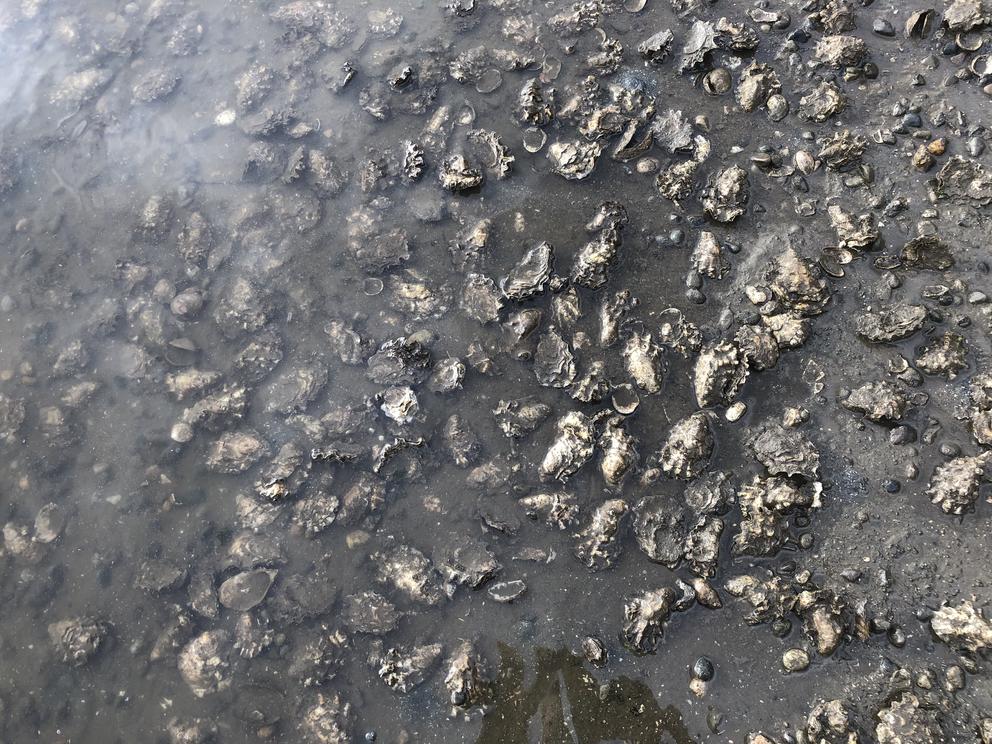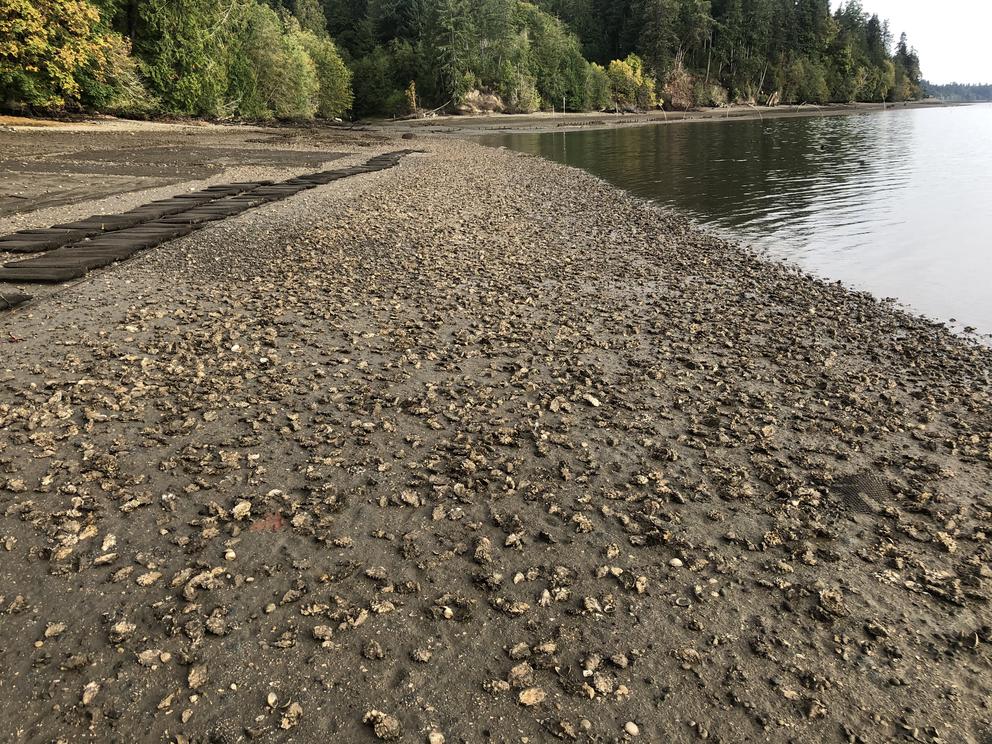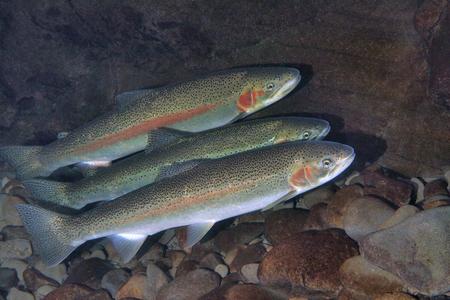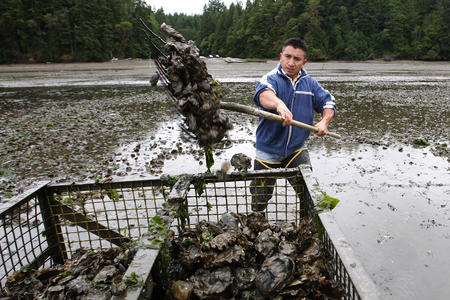“The restaurant market is so unpredictable,” she says. Fagergren sells to the larger Hama Hama Oyster Co. After months of uncertainty on whether restaurants would be open in the pandemic, Fagergren says she was advised to harvest oysters early while there seems to be a market.
The Fagergrens haven’t suffered financially yet, but that makes them an outlier among small shellfish growing operations: They don’t have employees, and didn’t have to lay anyone off. They had a natural break in their growing seasons that seemed to time with the pandemic.
“But this is now where we're entering unpredictable territory, because we've always had a very strong market for oysters, and we just don't know what's going to happen,” she says.
Washington’s iconic shellfish industry was one of the first to collapse in the pandemic. With the industry’s dependency on sales to Asia, the dual impact of COVID-19 in China in January and Chinese tariff wars before that brought losses for farms, hatcheries and distributors. But in March, “things really shut down,” says David Beugli, executive director of the Willapa-Grays Harbor Oyster Growers, which represents about 20 member farms.
According to Teri King with Washington Sea Grant, there are about 242 shellfish companies in the state, some with multiple farms. Jennifer Hennessey, the governor’s office shellfish policy adviser, says the industry supports nearly 3,000 jobs in the state and contributes hundreds of millions of dollars to the economy.
After seven months of widespread shellfish farm and hatchery layoffs and shutdowns, many growers report seeing business starting to come back, now that plants are back in action and growers can harvest. But just as many still worry about the future. Whether Washington continues to have access to local shellfish depends on opening new markets and seeing older ones rebound. In the meantime, growers are forced to make decisions with no clear picture of the future. And while state and federal aid could ease some pain for growers and hatcheries, if the worst comes to pass, Washingtonians could see less shellfish long after the pandemic ends.
The initial shellshock
Clam sales, heavily connected to the restaurant industry, were the first to disappear, Beugli says, dropping from thousands of pounds a month to zero in March. Oysters followed.
“At that time, everybody's sales dropped off to either nothing or, you know, maybe 30% of normal,” he says. Shipments to California restaurants, a huge market for Washington growers, ended up returned or canceled as restaurants closed down. “This group has always had such a high-demand product … that they’d never experienced anything like this.”
Margaret Pilaro, executive director of the Pacific Coast Shellfish Growers Association, which has at least 80 members in Washington state, says domestic demand fell 80% in the spring, with many members producing zero to 20% of the volume they normally would. “People in some cases were able to redirect staff to do more maintenance types of activity, but most of our members experienced anywhere from a 20% to upwards of a 75% reduction in staffing,” she says. “The effects of the pandemic have been devastating, regardless of the species or the location or the size of the farm.”
Early on, larger plants and growers suffered sizable layoffs. Taylor Shellfish, which operates farms, a hatchery and several oyster bars, saw business drop to a low of 25% of the previous year’s income in March, says senior director of public affairs Bill Dewey. At the end of 2019, the company employed just over 700 people; by April, that fell to 175, as most of the workforce was temporarily laid off (with benefits) or put on a shared work program with reduced hours. Dewey says many of those workers came from families with multiple members who had worked for the Taylor family for decades.
Some businesses qualified for federal Paycheck Protection Program loans that helped them stay afloat and keep employees on. Taylor was able to continue maintenance, perform seeding work and support oyster bar employees, thanks to a PPP loan, Dewey says. The Taylor family itself worked without pay for months, salaried managers took pay cuts, and the company sold off some real estate assets and put capital projects on hold.
Smaller companies specializing in only one or two types of products saw difficulties soon after, as fewer markets became available to them, and cashflow for salaries and new shellfish “seeds” (larvae for planting in beds) dried up.
Charlie Stephens of Kamilche Sea Farms, a small grower in Washington, says receiving PPP money and Small Business Administration grants made all the difference. “If we didn’t have that money in the bank, our bank account would be close to zero right now,” he says.
New markets to the rescue
Some growers and distributors who sold to supermarkets and grocery stores found themselves in better positions. With more people staying home and cooking more, many growers say interest in cooking shellfish at home has grown, too.
“It seems like it's going to be an ongoing demand, as more and more people are cooking at home,” says Ralph Riccio, a shellfish biologist and director of sales with the Jamestown S'Klallam Tribe, which grows shellfish and operates a hatchery.
At Taylor Shellfish, pre-pandemic gross revenue was approximately 75% from food service and 25% from the retail sector, Dewey says, noting that direct-to-consumer sales online are up 600%. “Today, as a result of the pandemic, that is reversed.”
Not all growers can shift so easily to consumer marketing. But for those that can, it opens up new markets for shellfish of differing sizes. To develop them, growers realized certain products were easier to cook at home, and designed ways to get those products directly to consumers.
Fagergren, who reached out to Hama Hama about selling clams in the summer when restaurants started opening back up, says the company’s initiative around direct-to-consumer sales has been a lifeline for small growers. She says Hama Hama hired a social media consultant and figured out how to ship oysters and clams directly to customers’ doorsteps. Fagergren says she also heard Hama Hama is partnering with a farm in South Seattle for an oyster drop-off site.
Growers have also created resources to help people prepare shellfish dishes for themselves.
“Because we are partnering with this other small family farm that has their finger on the pulse of how you have to adapt and change, we have really benefited from that relationship,” Fagergren says. “[Hama Hama] is doing the work of finding the markets and putting out YouTube videos of how to cook shellfish at home — and I think that that's really what it takes right now to inspire people to [do that].”
The resources are important because what’s appropriate for the home isn’t always the same as for a restaurant. The larger “shuck meat” and grilling oysters, at often more than 4 inches in diameter, wouldn’t work for raw oyster bars — but they are much more popular for home cooking.
Even more popular, Riccio and others say, are cooked clams for restaurants and home use, which Riccio believes some people see as more pandemic-safe than raw oysters. “People were running out of clams this year, up here in Washington, because the demand was so high,” he says.
Business is (kind of) back
While business is back, it has yet to boom.
Taylor Shellfish’s Dewey says that although the company has increased staffing to 500 employees and reopened all but one oyster bar at reduced capacity, May through August sales were 60% to 70% of what they were last year.
“While shellfish sales have returned, although not to prior levels, we are not able to make up for the lost sales revenue, and this will have a significant impact on profitability, operations and ability to reinvest in the company,” Dewey says.
And before growers can plant new shellfish, they have to harvest and sell existing ones. Uncertainty about markets may complicate that transition for some growers. Riccio says that earlier in the year, when Jamestown produced a lot of seeds, people didn’t have the money or the desire to purchase them without market demand.
“Even if they had money for seed, they didn't have the space,” Riccio says. “That's not everybody. But that was definitely a trend that I saw. It took a lot of the year moving forward, where people could start to sell those larger oysters and they could start to move those seeds.”
“People were more conservative in the amount of seed they purchased,” Beugli says. “So this year, there’ll be less seed planted than in years past.”
Farmers usually purchase seeds between April and September, and incubate them for early spring planting or in the fall, depending on the species. It can take years for some products to mature to the right size.
Depending on pandemic conditions, there may be fewer types of certain shellfish available years from now. Raw bar oysters need to be sold at smaller sizes after about 18 to 24 months; farmers who can’t find markets for those oysters might encounter problems once they grow to larger sizes.
“They have a lot of investment in an oyster like that — what they’ll do is sell it as a shucked meat or maybe grilling oyster, for a huge loss in cost,” Beugli says, “They're going to get too big to sell pretty soon here to restaurants.”
“We're in this very fragile place — I feel grateful in this moment, but things can happen so quickly,” Fagergren says. “We were able to sell products all summer long. We had money in the bank to buy the seeds, but it's all about space, and it's all about market. The idea of having to throw away a good oyster… I don't know what people have done to make room if they can't sell their product.”
One possible measure of hope for growers worried about making up seed costs is a new $300,000 state grant, which offers growers a one-time payment of up to $5,000. That can make a huge difference for small farms worried about offsetting costs.
"That makes a big difference to a lot of these small mom and pop farms that only buy maybe $10,000 worth of seeds,” says Riccio. “They're getting their seed costs covered and that's very helpful."
Hennessey, the governor’s office shellfish adviser, says 225 growers actively seeding shellfish in Washington would qualify for these seed grants. “That's not insignificant — we're hoping that as many of them that qualify will take advantage of this program to help them out,” she says.
But it’s a mere drop in the bucket for larger companies, growers say.
“In a lot of ways, it's not enough, but in some ways it's kind of what growers need to feel like they have a place here and an interest in continuing,” Pacific Coast Shellfish Growers Association’s Pilaro says. She says they’re still waiting to hear about Coronavirus Aid, Relief and Economic Security Act money coming through the National Oceanic and Atmospheric Administration. Hennessey says that there is a new U.S. Department of Agriculture commodity sales program that could also be helpful to growers.
“It's one thing if you have a crop that you can't market. It's another thing if that becomes a multiyear thing, potentially, if you're not planting,” says Laura Butler of the state Department of Agriculture. “We recognize that it's a small help, but there was a really big need there, and we wanted to try and do what we could to put some resources toward it.”
But Pilaro says with so many growers running multigenerational farms, there’s pride and tradition in being able to adapt. “We've got shellfish growers who have been around for a long time, operating without internet, and now find that they need to adapt to find customers through it, and that's really wild to think about,” she says. “[I’m] cautiously optimistic.”
“Shellfish growers are a very resourceful and resilient group,” says Washington Sea Grant’s King. “And if they're still able to have their doors open, I have no doubt that we will have crops in 2021. We just have to have a market and somebody to slurp it.”
Update: This article was updated at 9:08 a.m. on Oct. 9, 2020, to better reflect the number of shellfish farms in the state; and the nature of layoffs and staffing in the industry at the beginning of the pandemic.







